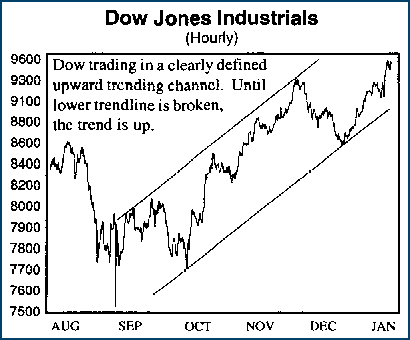The Trend is Up
Equities markets both at home and abroad took a surprising turn for the better in the final weeks of 1998. What looked to be a tenuous position for many major stock indices—the Dow Jones Industrials included—suddenly took a turn higher to close out a memorable (for many reasons) 1998.
There is no denying now that the trend remains up in the U.S. stock market, including the smaller-cap indices such as Value Line and Russell 2000. The domestic market is being led, of course, by the white hot Internet stocks which are witnessing a blow-off of Tulip Mania proportions. Overvaluations and shaky fundamental conditions notwithstanding, the tremendous momentum in the equities market coupled with a recovery in many major world stock markets should be enough to ensure a bullish first quarter 1999. Yes, the market can turn on a dime and we should be prepared at all times for just such a turn. But the charts unilaterally point to significantly higher levels in all the major indices in the very near future.
While the charts of the other major indices show clear-cut bullishness ahead, the Dow Industrials have been lagging for the past few weeks. Last week alone, the Industrials actually saw a net loss of nearly 30 points from the previous week while the S&P and Nasdaq rose to record highs. Even the lagging Dow Jones Transportation index finally mustered the strength to penetrate decisively above crucial 3100 resistance to close the week at 9149—a few points from the Fibonacci 62% retracement level at 3158. A further move higher in the Transports above 3158 would in all likelihood ensure a move toward the next major resistance level at 3600.

At the close of trading on Dec. 31, the Dow finished for the week at 9181 while every other index finished higher. Interestingly, NYSE trading volume was unusually high, especially for a pre-holiday session. Volume for the Dec. 31 session was 754,860,000. The advance/decline line was a very strong 2310 to 728—the best breadth reading in months. The ratio of new highs/lows was likewise impressive with a reading of 146 to 31. This presents a strong technical picture. Yet the Dow declined by one percent on Thursday and finished the week below the previous week's level. What gives?
It is entirely probable that this week will witness a pullback in the broad market after recent impressive gains. The Dow Industrials especially have given a clear warning of this by closing on its low trading price of the day on Thursday. With the Senate expected to begin discussing the Clinton impeachment this week, this would provide the perfect backdrop for a market correction. We do not forecast what the amplitude of the correction may be, only that there will be some sort of downward move in the Dow this week.
Note the clearly formed channel trendline in the Dow Industrial chart. As long as the lower trendline holds, the trend will continue higher. Any penetration of the lower trendline by a margin of 3% or more will serve as a warning signal to exit immediately long positions in the market. A conspicuously high volume penetration of lower trendline support, even if it is less than 3%, will also serve as adequate warning that the trend is about to change. Unless this happens, however, expect higher prices in the weeks ahead.
The Russell 2000 index has firmly penetrated the 50% resistance zone and is clearly retracing all of its summer losses, coming out of a bullish flag pattern. Ditto for the Value Line composite.
Money supply measures and an accomodative Fed interest rate policy will ensure a continuation of the overall bullish trend in early 1999. Unless the Fed suddenly "slams on the brakes," the insanity will continue for a while longer. At last reading, the M2 and M3 measures of money increased $19.0 billion and $17.4 billion, respectively.
The one question that everybody keeps asking is, "is it too late to get on board and take advantage of the uptrend in stocks?" The answer is no, it is never too late to buy or sell. We are reminded of a passage from the Wall Street classic, Reminiscences of a Stock Operator, a fictionalized biography of legendary trader Jesse Livermore, in which the main character states, "It is surprising how many experienced traders are who look incredulous when I tell them that when I buy stocks for a rise I like to pay top prices and when I sell I must sell low or not at all….[a trader] should accumulate his line on the way up." Another old Wall Street saying to keep in mind, especially those of you who are of a bearish inclination (like we are), is "never bet against the market when the sap is running up the trees." Some of the best gains in this market will be made in the coming weeks as the Dow heads toward the 11,000 mark. A good trader is never afraid to get on the long side of the market even when shaky fundamental conditions such as "overvaluations" prevail. To avoid disaster, set protective stops of 1% to 3% the current trading price of whatever issue you happen to be in.
In sum, while we expect a pullback this week, the market should continue to trend within the confines of its upward trending channel in the weeks ahead. However, as always, we are alert for the possibility of a sudden turnaround which is why we recommend fairly tight (but not restrictive) protective stops on all commitments. One thing we will promise—1999 should be even more interesting and momentous than 1998.
















